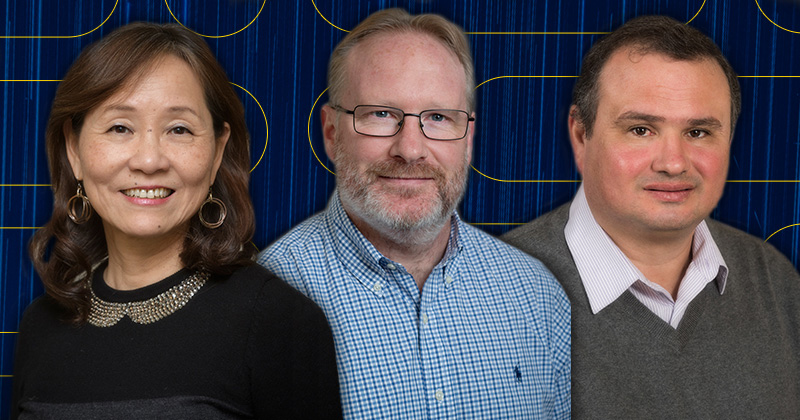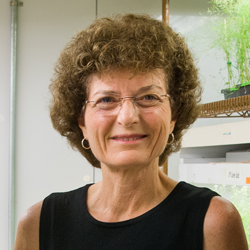


Highly Cited Researchers
Photo illustration by Joy Smoker December 19, 2018
Wu, Green, Brown and Janotti make list of top influencers
Research at the University of Delaware draws the attention of scientists, engineers and other researchers around the world and four UD researchers recently were named to the Clarivate Analytics list of Highly Cited Researchers for 2018. This list identifies scholars whose publications are in the top 1% for citations by other researchers via Web of Science, a scientific citation indexing service. Researchers can be cited for top performance in their field or for Cross-Field impact, a new category this year. The h-index is meant to measure a researcher’s individual output, assessing both quantity and impact. Google’s i10 index measures the number of papers with 10 or more citations.
Cathy Wu
Cathy Wu, the Unidel Edward G. Jefferson Chair in Engineering and Computer Science, the director of the Center for Bioinformatics and Computational Biology and the director of UD’s new Data Science Institute, has made the Highly Cited Researchers list for the fifth year in a row in the field of biology and biochemistry. Wu has published more than 260 peer-reviewed papers that have garnered more than 32,000 citations. Her work has an h-index of 60, and an i10-index of 165 based on Google Scholar.
Wu is a leader in the field of bioinformatics, analyzing large sets of data to extract meaning about biological phenomena. She has led or co-led several large multi-institutional consortium grant projects funded by the National Institutes of Health, the National Science Foundation and the Department of Energy. In 2002, she co-founded the international UniProt Consortium project, which has become a central hub for protein sequence and function. Many of her most highly cited works are related to this influential project. Wu leads UniProt’s Protein Information Resource, a research resource of protein informatics that supports integrated genomic and proteomic research and scientific discovery.
Cloud computing, text mining, data mining, machine learning and community annotation — all initiatives of UD’s new Data Science Institute — are important to Wu’s research. “It’s all about team science,” Wu said. “It is gratifying and a privilege to have worked with such an incredible multidisciplinary team of dedicated and talented researchers and students in the group and with our collaborators across the university, the region, and nationally and internationally.”

Pamela J. Green
Pamela J. Green is the Crawford H. Greenewalt Chair in the Department of Plant and Soil Sciences in the College of Agriculture and Natural Resources. She is also a professor in the School of Marine Science and Policy in the College of Earth, Ocean, and Environment with joint appointments in the departments of Biological Sciences and Chemistry and Biochemistry.
Green, who leads a laboratory at the Delaware Biotechnology Institute (DBI), has published more than 130 peer-reviewed papers and been cited more than 23,800 times, according to Google Scholar. Her work has an h-index of 74 and an i10 index of 116.
Her research focuses on post-transcriptional mechanisms that regulate the expression of genes, primarily in plants, but also in marine organisms and human cells. She is particularly interested in the fate of mRNA molecules because of their pivotal role as intermediates in the gene expression process. Her work investigates the regulatory roles of microRNAs, RNA degradation, ribonucleases, and environmental stress responses.
Craig M. Brown
Craig M. Brown is a staff chemist at the National Institute of Standards and Technology (NIST) center for Neutron Research and an adjunct professor through UD’s Center for Neutron Science, which was founded in 2007. Under a cooperative agreement with NIST, UD’s Center for Neutron Science advances the field of neutron scattering by developing new techniques, applying these techniques to new applications, and training the next generation of neutron scientists.
Brown, who studies the structure and dynamics of novel materials, made the 2018 Highly Cited Researchers list in the Cross-Field category. Among his most cited works are papers on molecular adsorption for energy efficient industrial separations, and hydrogen storage in materials, which hold promise in applications for cleaner energy and automotive technology. Brown has published more than 175 peer-reviewed papers, which have garnered more than 12,000 citations. His work has an h-index of 50, and an i10-index of 144 based on Google Scholar.
Anderson Janotti
Anderson Janotti, an assistant professor of materials science and engineering, made the Highly Cited Researchers list in the Cross-Field category. He has published more than 190 peer-reviewed papers, which have garnered more than 17,000 citations. His work has an h-index of 57, and an i10-index of 144 based on Google Scholar.
Janotti’s most cited works are related to the development of oxides as semiconductor materials, focusing on the role of intrinsic defects and impurities in controlling their electrical conductivity. His work on fundamentals of zinc oxide as semiconductor, co-authored by Chris Van de Walle, the Herbert Kroemer Distinguished Professor at the University of California at Santa Barbara, has been cited more than 2400 times. Among his highly cited works, a 2007 paper in Nature Materials stands out, where it was revealed a new type of chemical bond in solid materials, the hydrogen multicentre bond — in which a hydrogen atom equally bonds to four or more other atoms. “This was an exciting discovery with important consequences,” said Janotti. “People had tried for a long time to understand the role of hydrogen in oxide materials, and this helped to explain it.”
Janotti joined UD in 2015 and was recently part of a team that modeled the surfaces of half-Heusler compounds, particularly promising electronic materials. Their “electron counting model,” described in a paper in Science Advances, explains the atomic and electronic structure at these surfaces and could help other scientists and engineers utilize these materials more effectively going forward.
Contact Us
Have a UDaily story idea?
Contact us at ocm@udel.edu
Members of the press
Contact us at 302-831-NEWS or visit the Media Relations website

